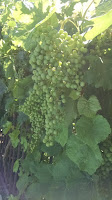- Will make shade, without needing to stake any structure or worrying about it blowing away in a wind storm
- Will create a microclimate in that section of the yard far more effectively than a shade structure will
- Will add fertility to the soil by making bacterial and fungal associations and multiplying that content in the soil via increased root mass (especially true if the trees are nitrogen-fixing)
- Will create free mulch via natural leaf dropping or intentional pruning
- Will create a nurse environment for a productive tree
- Nursed productive trees will establish faster due to the increased microbial activity in the soil
However this does require you to think ahead and get your temporary trees established first before you start planting your orchard. This really does pay off in the long run.
I have been putting this approach to good use for years in my yard. I use Moringa and Castor (Giant Zanibariensis) as fast growing canopy trees. And after 1-3 years I take them out once something becomes big enough to occupy that space. I have removed several trees this way. Today I removed two more.

Castor and Morninga were planted side by side to provide shade in my deciduous area. Castor was about 15 ft tall and Moringa was 25+ ft tall and provided significant shade. A Sweet Lavender Mulberry was planted in this area to be a productive tree that eventually provided the canopy in this area. Now that the Mulberry is big enough the Castor and Moringa have been stumped.

















